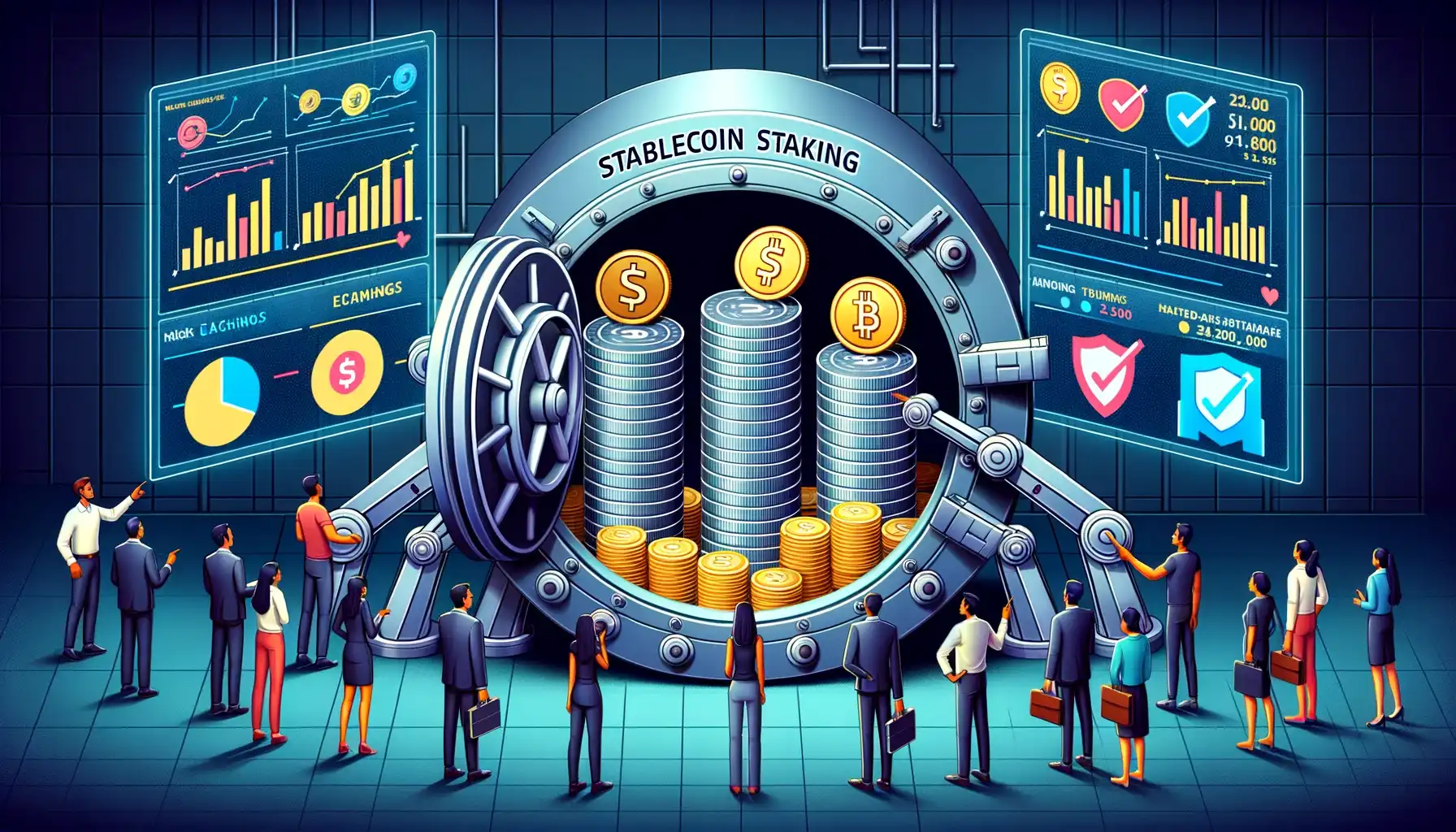Stablecoin staking is not just another buzzword in the cryptoverse; it’s a financial strategy that’s changing the game for investors.
If you’ve been looking for a way to earn consistent returns in the crypto market without the rollercoaster of volatility, you’ve come to the right place.
In this comprehensive guide, we’ll demystify stablecoin staking, explore its landscape, and arm you with the knowledge you need to get started.
Key Takeaways
Aspect Key Point Importance Stablecoin staking offers a risk-averse approach to crypto investments. Platforms Various platforms, both centralized and decentralized, offer stablecoin staking. Risks While generally safer, stablecoin staking is not without its risks, which can be mitigated. Yield Rates Yield rates can vary, but they generally offer better returns than traditional financial instruments. Getting Started Choosing the right platform and doing due diligence is key to successful stablecoin staking.
Whether you’re a novice dipping your toes into the crypto waters or a seasoned trader looking to diversify your portfolio, stablecoin staking offers a unique blend of safety and profitability.
We’ll delve into how to choose the right platform, the risks involved, and how to mitigate them. So, buckle up as we navigate the calm yet rewarding waters of stablecoin staking.
By the end of this guide, you’ll not only understand the ins and outs of stablecoin staking but also be well-equipped to make informed decisions that align with your financial goals.
And remember, here at CryptoMindPro, it’s not just about following the herd; it’s about understanding the terrain and making your own path.
So, are you ready to unlock the secrets of stablecoin staking? Let’s dive in!
The Landscape of Stablecoin Staking
Decentralized vs. Centralized Platforms
When it comes to staking your stablecoins, you have two main options: decentralized platforms (DeFi) and centralized platforms (CeFi).
Each has its own set of advantages and drawbacks, so let’s break it down:
Decentralized Platforms (DeFi)
- Pros
- No middlemen
- Full control over your assets
- Higher yield rates
- Cons
- Higher risk due to smart contract vulnerabilities
- Complexity in usage
Centralized Platforms (CeFi)
- Pros
- Easier to use
- Lower risk due to regulatory oversight
- Cons
- Lower yield rates
- Less control over your assets
Popular Platforms
There’s no shortage of platforms where you can stake your stablecoins.
Here are eight of the most popular ones:
Note: Always do your own research before choosing a platform. Yield rates and risk factors can vary.
For a deeper dive into DeFi platforms, check out our article on Best DeFi for Passive Income: Unlocking the Secrets of Ethereum’s Top 3 Platforms.
How to Choose a Platform
Choosing the right platform for stablecoin staking is more than just a click-and-go decision.
It’s a calculated move that requires a deep understanding of various factors.
In this section, we’ll guide you through the maze of choices and help you make an informed decision.
Risk Profiles
When it comes to staking, not all platforms are created equal.
Some offer higher yields but come with higher risks, while others offer a safer environment but with lower returns.
Here’s how to assess the risk profile of a platform:
- Smart Contract Risk: Platforms that rely on smart contracts could be vulnerable to hacks.
- Regulatory Risk: Some platforms may not be regulated, increasing the risk of fraud.
- Liquidity Risk: Ensure the platform has enough liquidity to handle withdrawals.
Yield Rates
Yield rates are often the most attractive feature of staking platforms, but they shouldn’t be the only factor in your decision.
Here’s what to consider:
- APY: Annual Percentage Yield can vary from one platform to another.
- Compounding: Some platforms offer compounding interest, which can significantly boost your returns over time.

User Interface and Experience
The user interface can make or break your staking experience.
Look for platforms that offer:
- Ease of Use: The platform should be intuitive, especially for beginners.
- Customer Support: A responsive customer support team can be invaluable.
- Additional Features: Some platforms offer extra features like staking calculators or educational content.
For more insights into generating income with stablecoins, don’t miss our article on How Do You Make Money on Stablecoins: Navigating the Calm Waters of Earning Opportunities in Crypto.
Getting Started
Ready to take the plunge into stablecoin staking? Excellent! But before you do, it’s crucial to understand that the process varies depending on the type of platform you choose.
In this section, we’ll break down the steps for both centralized and decentralized platforms.
Steps to Start Staking on Centralized Platforms (e.g., Binance, Coinbase)
Centralized platforms often provide a more user-friendly experience, especially for those new to the crypto space.
Here’s how to get started:
- Create an Account: Sign up with your email and create a password.
- Verify Identity: Complete the KYC (Know Your Customer) process.
- Deposit Stablecoins: Use the platform’s deposit feature to add stablecoins to your account.
- Navigate to Staking Section: Go to the staking or finance section on the platform.
- Choose and Confirm: Select your stablecoin and the staking period, then confirm.
Note: Centralized platforms often have customer support to assist you through the process.
Steps to Start Staking on Decentralized Platforms (e.g., Curve Finance, Yearn Finance, PancakeSwap)
Decentralized platforms offer more control but can be a bit complex.
Here’s your roadmap:
- Connect Wallet: Link your crypto wallet like MetaMask or Trust Wallet.
- Transfer Stablecoins: Send stablecoins from your wallet to the platform.
- Select Staking Pool: Navigate to the staking section and choose a pool.
- Approve and Stake: Approve the transaction in your wallet and start staking.
Note: Always double-check smart contract addresses to avoid scams.
Importance of Due Diligence
Regardless of the platform type, due diligence is non-negotiable.
Here are some pointers:
- Read Reviews: User reviews can offer valuable insights.
- Check Security: Make sure the platform has robust security measures.
- Understand Terms: Know the staking and withdrawal conditions.
For more on stablecoin safety, delve into our article on Are Stablecoins Safe? A Dive into the Safety Nets and Snags of Stablecoins.
Risks and How to Mitigate Them
Stablecoin staking is often touted as a low-risk investment, but let’s be real: no investment is entirely without risk.
In this section, we’ll delve into the potential pitfalls you might encounter and how to sidestep them like a pro.
Smart Contract Risks
When dealing with decentralized platforms, smart contract vulnerabilities are a concern.
Here’s how to mitigate these risks:
- Audit Reports: Look for platforms that have undergone security audits.
- Community Feedback: A strong and active community can often spot and report issues faster.
- Insurance: Some platforms offer insurance options for your staked assets.
Platform Risks
Whether centralized or decentralized, platforms themselves can pose risks.
Here’s what to watch out for:
- Regulatory Compliance: Ensure the platform complies with regulations to avoid legal complications.
- Operational Security: Check if the platform has a history of security breaches or other operational issues.
Market Risks
Stablecoins aim to be stable, but market conditions can affect them.
Here’s how to stay ahead:
- Diversification: Don’t put all your eggs in one basket; diversify your staking platforms and stablecoins.
- Regular Monitoring: Keep an eye on market news that could affect stablecoin stability.
Maximizing Your Returns
You’re not just here to play it safe; you’re here to win. And winning in the world of stablecoin staking means maximizing your returns without taking reckless risks.
In this section, we’ll show you how to do just that.
Strategies for Higher Yields
There are several strategies to consider if you’re looking to maximize your staking returns.
Here are some of them:
- Compound Interest: Platforms that offer compounding can significantly boost your returns over time.
- Variable Rates: Some platforms offer variable rates that can be more lucrative.
- Multi-Platform Staking: Diversifying across multiple platforms can offer better yield opportunities.
Tax Implications
Yes, the taxman cometh—even in the world of crypto.
Here’s what you need to know:
- Report Earnings: In most jurisdictions, staking rewards are considered taxable income.
- Keep Records: Maintain detailed records of your transactions for tax purposes.
Note: Always consult a tax advisor familiar with cryptocurrency regulations in your jurisdiction.
Monitoring and Adjusting
Staking isn’t a set-it-and-forget-it game. Here’s how to keep tabs on your investments:
- Regular Check-ins: Make it a habit to check your staking status and yields.
- Adjust Strategy: Be ready to adjust your staking strategy based on performance and market conditions.
The Final Word: Your Roadmap to Stablecoin Staking Success
You’ve made it to the end of this comprehensive guide, and by now, you should be armed with all the knowledge you need to dive into the world of stablecoin staking.
From understanding the landscape and choosing the right platform to mitigating risks and maximizing returns, we’ve covered it all.
So go ahead, take that plunge into stablecoin staking.
Just know that you’re not diving in alone; we’re right here with you, every step of the way.
Feel free to drop any questions, insights, or feedback you may have.
We’re all ears and always eager to engage with our community.
Happy staking!
Frequently Asked Questions: Your Quick Guide to Stablecoin Staking
| Question | Answer |
| What is stablecoin staking? | Stablecoin staking is the process of locking up your stablecoins in a smart contract or on a platform to earn interest or rewards. |
| Is stablecoin staking safe? | While generally considered safer than other crypto investments, stablecoin staking is not without risks. Always do your due diligence before staking. |
| How do I start staking? | The process varies depending on the platform. Centralized platforms usually require account creation and KYC, while decentralized platforms require a connected crypto wallet. |
| What are the returns like? | Returns can vary widely depending on the platform and the stablecoin. Always check the Annual Percentage Yield (APY) before staking. |
| Are there any fees? | Fees can include transaction fees for depositing and withdrawing stablecoins, as well as potential performance fees on some platforms. |
| Can I lose my money? | While stablecoin staking is generally low-risk, there’s always a possibility of loss due to smart contract failures, platform risks, or market volatility. |
| Do I have to pay taxes on my earnings? | In most jurisdictions, earnings from stablecoin staking are considered taxable income. Consult a tax advisor for specific guidance. |
| How often should I check my staking status? | Regular monitoring is advised. Market conditions can change, and it’s good to be proactive about adjusting your strategy. |
| Can I stake on multiple platforms? | Yes, diversifying your staking across multiple platforms can help maximize returns and mitigate risks. |
| Where can I learn more? | You’re already in the right place! CryptoMindPro offers a wealth of articles and guides to deepen your understanding of stablecoin staking and other crypto topics. |




